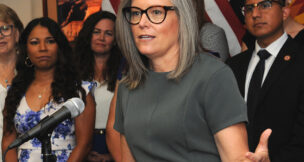Officials: Maricopa, Pima, Coconino will qualify for federal road money – probably
Arizona Capitol Reports Staff//March 12, 2009//[read_meter]
Officials: Maricopa, Pima, Coconino will qualify for federal road money – probably
Arizona Capitol Reports Staff//March 12, 2009//[read_meter]
State transportation officials are confident that a provision of the federal stimulus act that requires transportation spending to focus on economically distressed areas won't prevent Arizona's three biggest population centers...











